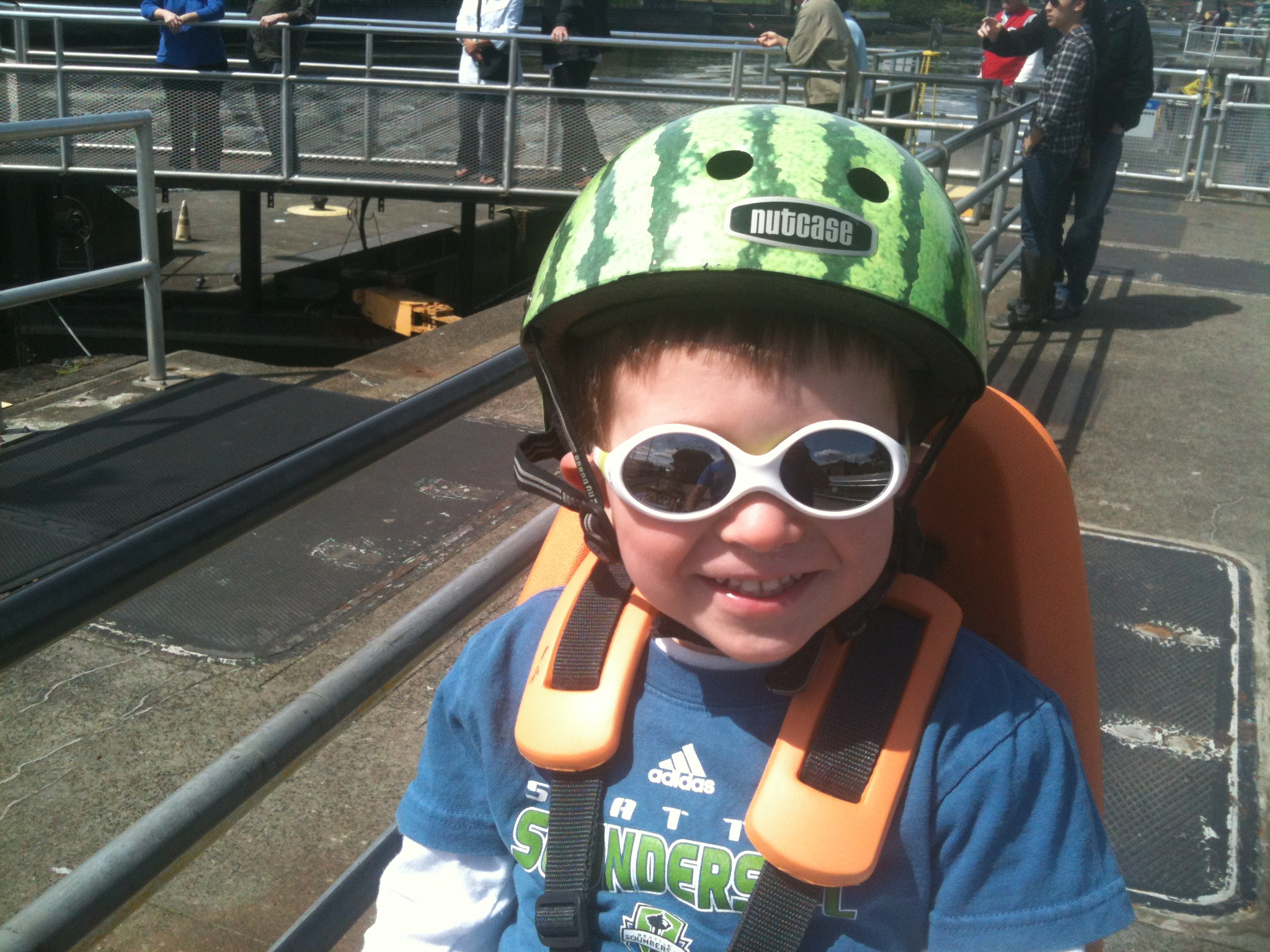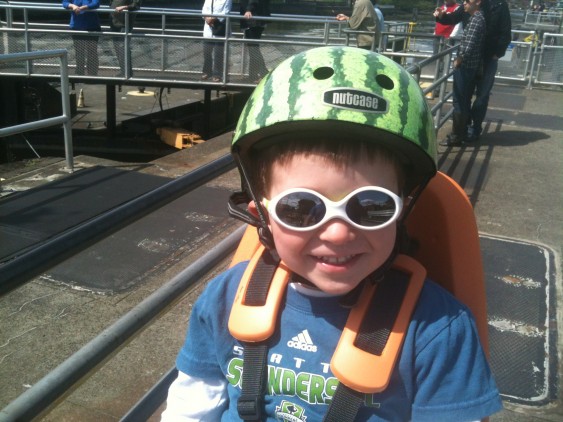Editor’s note September 2017: Did you catch our first installment of Babes on Bikes? Check out more family-biking testimonials and community resources below. Enjoy riding with your wee one! (Maybe you will even be inspired to tow your tot to the first day of school!)
Since the first Babes on Bikes post, my 2 1/2 year old daughter Audrey and I have gone on a couple longer rides together. Despite some wobbles here and there I’m really getting the hang of it. We had a blast riding from Montlake to the Ballard farmers’ market on the Burke Gilman trail, rolling past hundreds of women half-marathon runners (Audrey thought everyone on the sidelines was cheering for us.)
Also since the first post, all kinds of new photos and resources have poured in from readers. So, here’s Babes on Bikes II—more family-biking eye-candy and more community support, plus some new city bike infrastructure data, and info about bicycle advocacy efforts.

Courtesy of Madi C.
Bike-Friendly Streets
Now that I’ve taken to the mean streets of Seattle with my precious cargo, I have a new appreciation for the city’s bike infrastructure. I’ll never enjoy riding right in heavy car traffic, but I’d gotten used to it when riding solo. But with my kid on board, the buffer of a simple, painted bike lane goes a long way toward my sense of safety and comfort. More than ever I’m aware that the better the bike infrastructure, the more freedom I have to make choices about getting around.

Courtesy of familyride.wordpress.com.
For a hot-off-the-presses look at Seattle’s bicycle infrastructure and comparisons to Portland and other leading bike cities in the nation, see Cascade Bicycle Club’s 2012 Seattle Bicycle Report Card.
Here’s Cascade’s city by city comparison for various types of infrastructure, from trails to greenways to lanes and sharrows. As you can see, Seattle trails Portland in both existing and planned infrastructure—and other cities across the US are leading on efforts to make their streets more bike-friendly in coming years.
Other cities in the region are working on being bike friendly too. Eugene, OR boasts 42 miles of shared-use paths, 81 miles of on-street bicycle lanes, 35 miles of signed bikeways, 5 bicycle/pedestrian bridges spanning the Willamette River, and 2 bicycle/pedestrian bridges spanning major roads or highways.

Photo by Patrick Barber.
Vancouver, BC has plans for improved bike infrastructure. A recently released draft transportation plan “envisions an even more aggressively bike-friendly city, where trips by car are reduced from the current 60 per cent to only 33 per cent by 2040. By then, there would be a comprehensive network of bike lanes, a focus on routes that link high-use locations and substantially improved bike facilities in high-rider areas.”

Lisa and Linnaeus in Vancouver, BC.
Bike-friendly streets are crucial. But bike-friendly workplaces also boost the numbers of commuters who choose to leave their car at home. Stuff as simple as a place to park your bike, a locker and a shower to use at work make employees 5 times more likely to commute by bicycle.
Check out more bicycle research here.

Courtesy of Brad H.
Bicycle Advocacy
All this bike infrastructure doesn’t just magically appear. Advocates for safe transportation choices are hard at work developing and supporting policies and investments “that make roadways more accessible and convenient for bicycling and safer for all road users.” (That’s how Cascade Bicycle Club puts it. You can find out how to get involved on their website.)

Courtesy of Marc L.
The Bicycle Transportation Alliance is a nonprofit organization that promotes bike infrastructure in Oregon. They provide all kinds of resources, including legal help for anyone involved in a crash and ways to get involved in policy solutions.

Courtesy of Emily F.
The Vancouver Cycling Coalition does similar advocacy work—promoting bike-friendly infrastructure and policies and also organizing events and hosting classes and workshops.

Courtesy of Todd Bosworth.
Mari sent in some lovely photos of her biking family. Her website, Bicycling Monterey, is chock full of info on local family bike activities and resources, as well as ways to get involved in local bicycle advocacy efforts.

Courtesy of bicyclingmonterey.com.
Building Family Bicycle Community
Biking with kids is not only a way to get to know your neighborhood, up close and personal. It’s also a way to get to know other families. There are all kinds of rides and workshops and meetups for beginners and seasoned cyclists alike.

Courtesy of Kelly Hogaboom.
I mentioned Davey Oil of Bike Works in my first post. He has a personal bike blog too; it’s worth checking out his excellent series on beginning to bike with kids.

Courtesy Davey O. Photo by Russ Rocca, of Path Less Pedaled.
Davey’s colleague Morgan, Bike Works’ Family Biking Specialist (and bike mama), also sent along a schedule of upcoming Seattle events for bike babes and their parents, including a family biking for beginners class this Sunday (July 29) and a series of street smarts classes too.

Photo courtesy Morgan S.
Bike Works also has a rental fleet so families can try out riding together, as Morgan put it,
“without a huge equipment outlay,” and family bike expos so people can get a close-up look at different setups. (Upcoming expos will be during the Rainier Valley Heritage Parade and Summer Streets and Mt Baker Day in the Park—both in August.)

Courtesy of Madi C.
Julian, of Totcycle, has been organizing Kidical Mass rides for several years now, primarily in north and northwest Seattle. Bike Works is doing south end rides (primarily Rainier Valley) on the 3rd Sat of every month, from 11-2. These are short, family-friendly rides. (Interested? Meet at Bike Works.)

Courtesy of totcycle.com
GEARS—the Greater Eugene Area Riders—also organizes street safety and bike maintenance classes. They’re also a nonprofit bicycle rights and advocacy organization.

Courtesy of bicyclingmonterey.com.
And there’s online social media communities to be found too. There’s Seattle Family Biking on Facebook. There’s Getting Around Issaquah Together. There’s Vancouver Bicycle Club. And these cargo bike Facebook groups: Revolutions Per Minute and Cargo Cyclists. I’m sure there are countless more—you just have to poke around a bit. (Can’t find one for your town? Start one!)
For more community info, fun stories, and practical advice, see also: Family Ride, I Bike U Bike, and The Main Tank.

Courtesy of M. Kriegel.
Going Mainstream
Momentum Magazine recently called cargo bikes “the new family vehicle” as well as “a vehicle that will change your life.” It’s a stretch. A cargo bike—or any biking for that matter, for anything other than pleasure—is still out of reach for most families. But maybe that will change as bikes get cheaper, infrastructure improves, and cultural norms shift.

Courtesy of familyride.wordpress.com.
I like how Sightline guest blogger Christine Grant (and Henry Cutler) described a potential evolution in our relationship with bikes as we increasingly assess them for their practicality and utility rather than their speed and racing performance—the way we would a car:
Henry Cutler, the Dutch-American owner of WorkCycles in Amsterdam, is convinced that urban cycling will explode once Americans get off high performance bikes and on to bikes that are upright, comfortable, and utilitarian. “Americans ride bikes that are like race cars; Dutch bikes are like Honda Civics and mini-vans,” Cutler joked last July as I admired his fleet of practical bikes. They come outfitted with child seats, baskets, bells, chain guards, and front and rear lights powered by your pedaling. Oh, and kickstands: Why don’t bikes have kickstands anymore?

Courtesy of Todd Bosworth.
Seeing is Believing
Part of an evolving relationship with bikes and transportation is shifting what’s normal. So, one motivation for posting all these photos is that stuff like this is contagious. The more you see people doing something like this, the more possible it seems to get started yourself. As Christine Grant also pointed out here recently, “The average US worker now spends about 48 minutes commuting each day. Despite the billions of hours we collectively spend commuting, we don’t often talk about the way our transportation choices make us feel—physically or mentally.”
Biking feels good. It wakes us up to our surroundings and keeps us alert and alive! And there’s no denying that these people who have shared photos with us look great!

Courtesy of bicyclingmonterey.com.
Seeing is believing. It happened to me; I saw parents out there with kids on bikes and it looked like a ton of fun. Now it’s happening to my husband who’s jealous of my rides with our toddler and wants to get his bike outfitted too.

Courtesy of bicyclingmonterey.com.
After you read this post you’ll start noticing more and more family bikes on the streets—and maybe you’ll be inspired to join us!
Don't forget to check out the original Babes on Bikes post here.










